SHINING EUROSTAR
Page 24
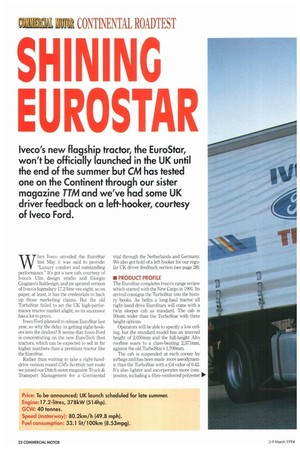
Page 26
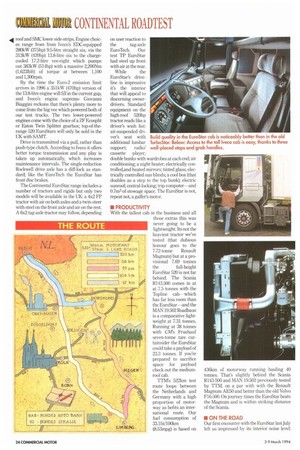
Page 27
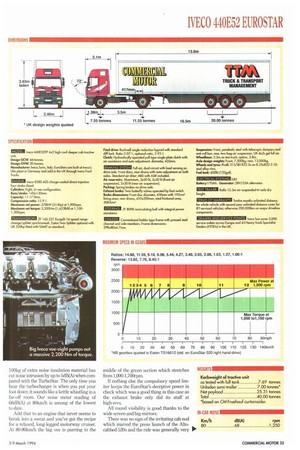
Page 28
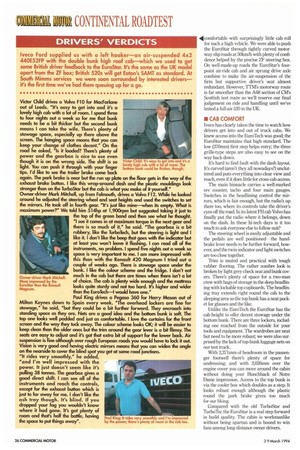
Page 29
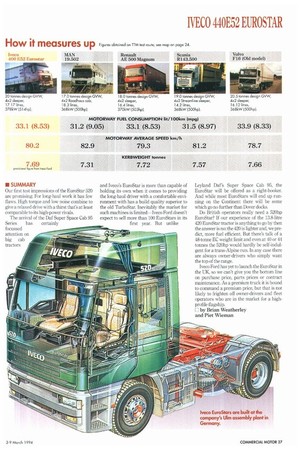
If you've noticed an error in this article please click here to report it so we can fix it.
lveco's new flagship tractor, the EuroStar, won't be officially launched in the UK until the end of the summer but CM has tested one on the Continent through our sister magazine TTM and we've had some UK driver feedback on a left-hooker, courtesy of Iveco Ford.
When Iveco unveiled the EuroStar last May it was said to provide: "Luxury comfort and outstanding performance." It's got a new cab, courtesy of Iveco's Ulm design studio and Giorgio Giugiaro's Italdesign, and an uprated version of Iveco's legendary 17.2-litre vee-eight, so on paper, at least, it has the a-edentials to back up those marketing claims, But the old TurboStar failed to set the UK high-performance tractor market alight, so its successor has a lot to prove.
Iveco Ford planned to release EuroStar last year, so why the delay in getting right-hookers into the dealers? It seems that Iveco Ford is concentrating on the new EuroTech fleet tractors, which can be expected to sell in far higher numbers than a premium tractor like the EuroStar.
Rather than waiting to take a right-handdrive version round C.114's Scottish test route we joined our Dutch sister magazine Truck & Transport Management for a Continental trial through the Netherlands and Germany. We also got hold of a left-hooker for our regular UK driver feedback section (see page 28).
• PRODUCT PROFILE
The EuroStar completes Iveco's range review which started with the New Cargo in 1991. Its arrival consigns the TurboStar into the history books. As befits a long-haul tractor all right-hand-drive EuroStars will come with a twin sleeper cab as standard. The cab is 50mm wider than the TurboStar with three height options.
Operators will be able to specify a low ceiling, but the standard model has an internal height of 2,050mm and the full-height Alto roofline soars to a class-beating 2,371min, against the old TurboStar's 1,700mm.
The cab is suspended at each corner by airbags and has been made more aerodynamic than the TurboStar with a Cd value of 0.42. It's also lighter and incorporates more composites. including a fibre-reinforced polyester PIP° .4 roof and SMC lower side-strips. Engine choices range from from Iveco's EDC-equipped 280kW (375hp) 9.5-litre straight six, via the 313kW (420hp) 13.8-litre six to the chargecooled 172-litre vee-eight which pumps out 383kW (514hp) with a massive 2,200Nm (1,6231tit) of torque at between 1,103 and 1,300rpm.
By the time the Euro-2 emission limit arrives in 1996 a 351kW (470hp) version of the 13.8-litre engine will fill in the current gap, and Iveco's engine supremo Giovanni Biaggini reckons that there's plenty more to come from the big vee which powered both of our test trucks. The two lower-powered engines come with the choice of a 71' Ecosplit or Eaton Twin Splitter gearbox; top-of-therange 520 EuroStars will only be sold in the UK with SAMT.
Drive is transmitted via a pull, rather than push-type clutch. According to Iveco it offers better torque transmission and any play is taken up automatically, which increases maintenance intervals. The single-reduction Rockwell drive axle has a diff-lock as standard; like the EuroTech the EuroStar has front disc brakes.
The Continental EuroStar range includes a number of tractors and rigids but only two models will be available in the UK: a 4x2 FP tractor with air on both axles and a twin-steer with steel on the front axle and air on the rest A 6x2 tag-axle tractor may follow, depending on user reaction to the tag-axle EuroTech. Our test TP EuroStar had steel up front with air at the rear.
While the EuroStar's driveline is impressive it's the interior that will appeal to discerning ownerdrivers. Standard equipment on the high-roof 520hp tractor reads like a driver's wish list: air-suspended driver's seat with additional lumbar support; radio/ cassette player; double bunks with wardrobes at each end; air conditioning; a night heater; electrically controlled,and heated mirrors; tinted glass; electrically controlled sun blinds; a cool box (that doubles as a step to the top bunk); electric sunroof; central-locking; trip computer—and 0.7m3 of stowage space. The EuroStar is not, repeat not, a gaffer's motor.
• PRODUCTIVITY With the tallest cab in the business and all those extras this was never going to be a lightweight. Its not the heaviest tractor we've tested (that dubious honour goes to the 7.72-tonne Renault Magnum) but at a provisional 7.69 tonnes , 476k m MOTORWAY 591cm 2 LANE ROADS
1100 km
the full-height EuroStar 520 is not far behind. The Scania R143.500 comes in at at 7.5 tonnes with the Topline cab—which has far less room than the EuroStar and the MAN 19502 Roadhaus is a comparative lightweight at 7.31 tonnes. Running at 38 tonnes with CM's Fruehauf seven-tonne tare curtainsider the EuroStar could take a payload of 23.3 tonnes. If you're prepared to sacrifice space for payload check out the mediumroof cab.
TTM's 522km test route loops between the Netherlands and Germany with a high proportion of motorway as befits an international route. Our fuel consumption of 33.114./1001on (8.53mpg) is based on 4361cm of motorway running hauling 40 tonnes. That's slightly behind the Scania R143-500 and MAN 19.502 previously tested by rrm, on a par with with the Renault Magnum AE50 and better than the old Volvo F16-500. On journey times the EuroStar beats the Magnum and is within striking distance of the Scania.
• ON THE ROAD
Our first encounter with the EuroStar last July left us impressed by its interior noise level:
100kg of extra noise insulation material has cut noise intrusion by up to 5dB(A) when compared with the TurboStar. The only time you hear the turbocharger is when you put your foot down: it sounds like a kettle whistling in a far-off room. Our noise meter reading of 68dB(A) at 80km/h is among of the lowest to date.
Add that to an engine that never seems to break into a sweat and you've got the recipe for a relaxed, long-legged motorway cruiser. At 80-90km/h the big vee is purring in the middle of the green section which stretches from 1,000-1,700rpm.
If nothing else the compulsory speed limiter keeps the EuroStar's deceptive power in check which was a good thing in this case as the exhaust brake only did its stuff at high revs.
All round visibility is good thanks to the wide screen and big mirrors.
There was no sign of the irritating cab nod which marred the press launch of the Altocabbed 520s and the ride was generally very 1111* 44cornfortable with surprisingly little cab roll for such a high vehicle. We were able to push the EuroStar through tightly curved motorway slip roads at 50Icm/h with plenty of confidence helped by the precise Zlz steering box. On well-made-up roads the EuroStar's fourpoint air-ride cab and air sprung drive axle combine to make the air-suspension of the firm but supportive driver's seat almost redundant. However TTM's motorway route is far smoother than the A68 section of CM'S Scottish test route so we'll reserve our final judgement on ride and handling until we've tested a full-air 520 in the UK.
• CAB COMFORT Iveco has clearly taken the time to watch how drivers get into and out of truck cabs. We knew access into the EuroTech was good; the EuroStar maintains that high standard The low (370mm) first step helps entry; the three grille-type steps are also easy to see on the way back down.
It's hard to find fault with the dash layout. It's curved (aren't they all nowadays?) uncluttered and puts everything into clear view and reach, even if it does little for cross-cab access.
The main binnacle carries a well-marked rev counter, tacho and four main gauges. Switches in the headlining control the mirrors, which is fair enough, but the radio's up there too, where its controls take the driver's eyes off the road, ht its latest FH cab Volvo has finally put the radio where it belongs, down on the dash. In these hi-tech days is it too much to ask everyone else to follow suit?
The steering wheel is easily adjustable and the pedals are well positioned—the handbrake lever needs to be further forward, however, and the twin indicator and light switches are too close together.
Trim is muted and practical with tough rubber flooring The rather sombre look is broken by light grey check seat and bunk covers. There's plenty of space for a two-man crew with bags of storage in the deep headlining with lockable top cupboards. The headlining tray extends right round the cab to the sleeping area so the top bunk has a neat pocket for glasses and the like.
Unlike the EuroTech the EuroStar has the cab height to offer decent stowage under the bottom bunk There are three lockers, including one reached from the outside for your tools and equipment The wardrobes are neat but need to be more robust we were also surprised by the lack of top-bunk luggage nets on our test truck
With 2,371mm of headroom in the passenger footwell there's plenty of space for undressing and with 2,026mm over the engine cover you can move around the cabin without doing your Hunchback of Notre Dame impression. Access to the top bunk is via the cooler box which doubles as a step. It looks robust enough although the plastic round the park brake gives too much for our liking.
Compared with the old TurboStar and TurboTec the EuroStar is a real step forward in build quality. The cabin is workmanlike without being spartan and is bound to win fans among long-distance owner-drivers.
• SUMMARY
Our first test impressions of the EuroStar 520 are promising. For long-haul work it has few flaws. High torque and low noise combine to give a relaxed drive with a thirst that's at least comparable to its high-power rivals.
The arrival of the Daf Super Space Cab 95 Series has certainly focussed attention on big cab tractors and Iveco's EuroStar is more than capable of holding its own when it comes to providing the long-haul driver with a comfortable environment with has a build quality superior to the old TurboStar. Inevitably the market for such machines is limited-Iveco Ford doesn't expect to sell more than 100 EuroStars in its first year. But unlike Leyland Daf's Super Space Cab 95, the EuroStar will be offered as a right-hooker. And while most EuroStars will end up running on the Continent there will be some which go no further than Dover docks.
Do British operators really need a 520hp EuroStar? If our experience of the 13.8-litre 420 EuroStar tractor is anything to go by then the answer is no: the 420 is lighter and, we predict, more fuel efficient. But there's talk of a 48-tonne EC weight limit and even at 40 or 44 tonnes the 520hp would hardly be self-indulgent for a trans-Alpine run. In any case there are always owner-drivers who simply want the top of the range.
Nem Ford has yet to launch the EuroStar in the LT, so we can't give you the bottom line on purchase price, parts prices or contract maintenance. As a premium truck it is bound to command a premium price, but that is not likely to frighten off owner-drivers and fleet operators who are in the market for a highprofile flagship.
E by Brian Weatherley
and Piet Wieman
















































































